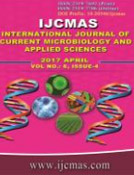


 National Academy of Agricultural Sciences (NAAS)
National Academy of Agricultural Sciences (NAAS)

|
PRINT ISSN : 2319-7692
Online ISSN : 2319-7706 Issues : 12 per year Publisher : Excellent Publishers Email : editorijcmas@gmail.com / submit@ijcmas.com Editor-in-chief: Dr.M.Prakash Index Copernicus ICV 2018: 95.39 NAAS RATING 2020: 5.38 |
CCD is an autosomal dominant disorder caused by haploinsufficiency of Runt related transcription factor (RUNX2) essential for osteoblast cell commitment and chondrocyte maturation. A mutation of the RUNX2 (Core Binding Factor-α1 gene located at chromosome 6p21) is usually caused CCD. In general, the estimated prevalence of CCD is under diagnosed because of the relative lack of medical complications in comparison to other skeletal dysplasias. No available data on the prevalence of CCD or its characterization in Saudi families. In the present study, a Saudi family consists of a father, a mother, three daughters and one son was analyzed for mutation detection in seven exons (2, 4, 5, 6, 7, 8 and 9) of RUNX2 gene with flanking intronic boundaries. Diagnosis of CCD is mostly made on the basis of clinical and radiographic features. The results of scans in the skull, jaw, chest, pelvis and hand and wrist radiographs were evaluated. The clinical findings obtained clarified that the mother is normal, but the father and the youngest daughter are affected with classical CCD, while the son and the two elder daughters have dental anomalies only. While, we could not establish any phenotype-genotype correlation, a heterozygous mutation was detected in Intron2; a (T) nucleotide is substituted with a (C) nucleotide in the position 5565 of RUNX2 gene in the father, the son and the three daughters. These findings suggest that it has a regulatory function related with teeth differentiation. CCD clinical features are present at birth, but they are often diagnosed at a much later time. Family history, pathognomonic clinical and radiographic findings play a central role in the diagnosis of CCD. While this is the case, there is a necessity to develop an early detection technique in order to enable early treatment of affected cases.
 |
 |
 |
 |
 |